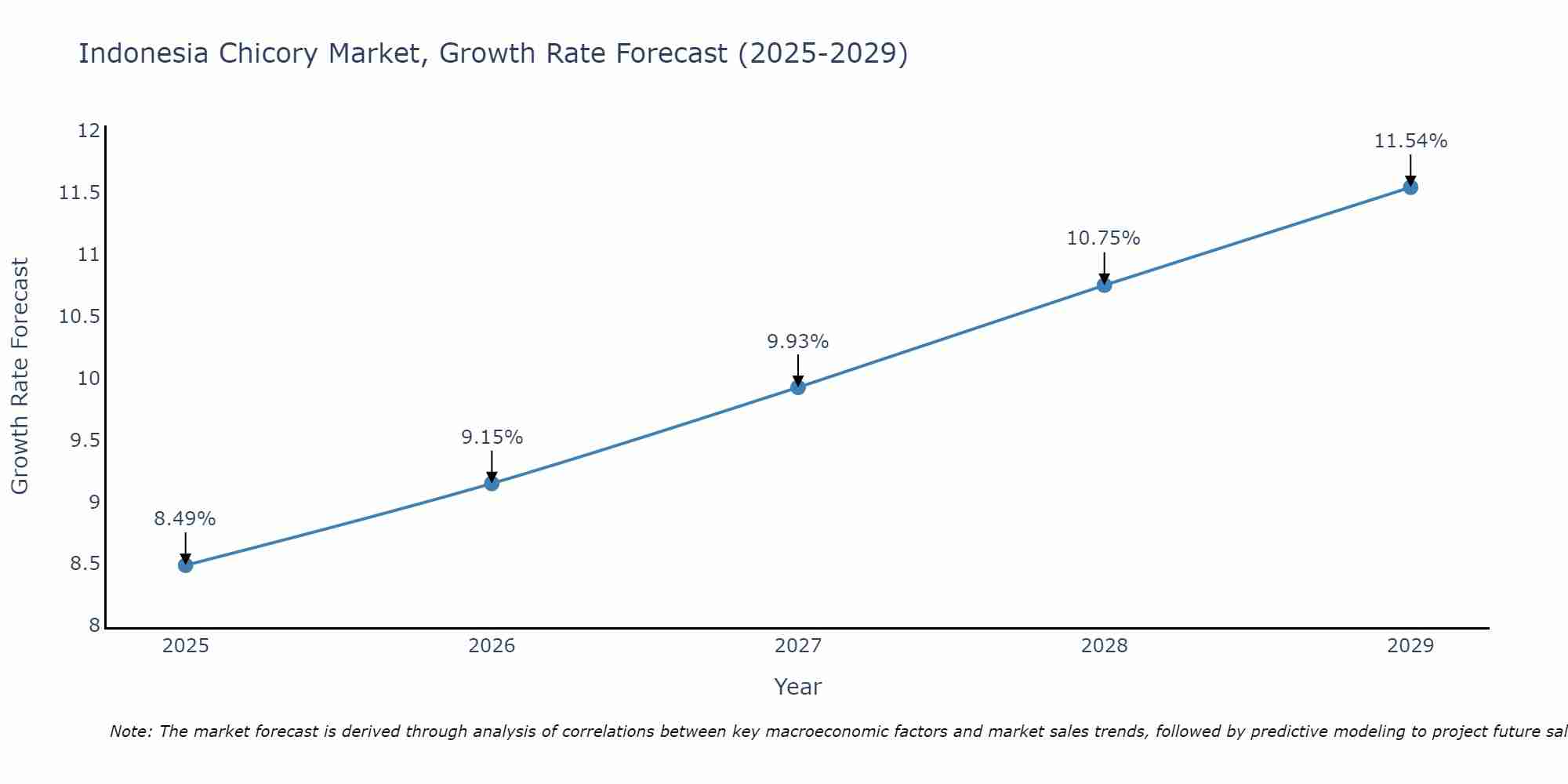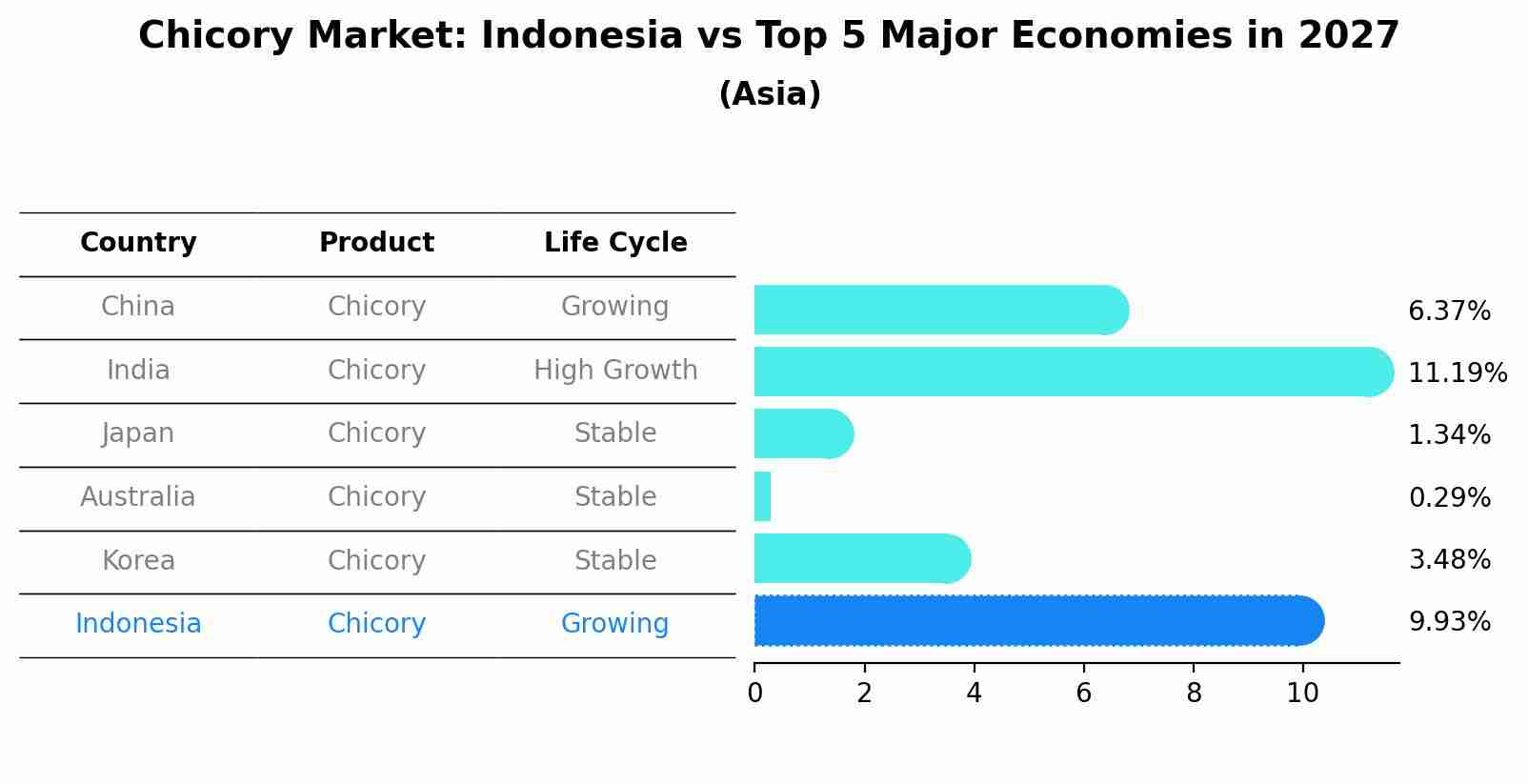Indonesia Chicory Market | Industry, Revenue, Value, Forecast, Analysis, COVID-19 IMPACT, Growth, Trends, Size, Companies & Share
| Product Code: ETC176567 | Publication Date: Jul 2023 | Updated Date: Apr 2025 | Product Type: Market Research Report | |
| Publisher: 6Wresearch | No. of Pages: 70 | No. of Figures: 35 | No. of Tables: 5 | |
Indonesia Chicory Market Size Growth Rate
The Indonesia Chicory Market is likely to experience consistent growth rate gains over the period 2025 to 2029. Commencing at 8.49% in 2025, growth builds up to 11.54% by 2029.

Chicory Market: Indonesia vs Top 5 Major Economies in 2027 (Asia)
In the Asia region, the Chicory market in Indonesia is projected to expand at a growing growth rate of 9.93% by 2027. The largest economy is China, followed by India, Japan, Australia and South Korea.

Indonesia Chicory Market Synopsis
Indonesia is the world`s second-largest producer of chicory, a perennial herbaceous plant used for its medicinal and culinary properties. Chicory has been an important crop in Indonesia since it was first introduced to the country in the late 19th century. It is primarily used as a coffee additive or substitute, though it also has many other beneficial uses such as animal feed, soil amendment, and alternative sweetener production.
Market Trends
In recent years there has been an increased demand for organic chicory products from Indonesia due to its potential health benefits. The popularity of traditional Indonesia beverages such as kopi luwak (civet cat coffee) have further raised awareness of this product and led to greater consumer interest in high quality chicory varieties produced in Indonesia. There are numerous small-scale producers operating throughout the country who specialize in producing specialty grade organic chicory products that cater to specific market needs both domestically and abroad.
Market Drivers
There are several factors driving growth within the Indonesia chicory market including higher disposable incomes amongst consumers leading to increased demand for premium coffee additives/substitutes; growing imports of green beans into Indonesia which is helping create new markets for domestic production; increasing international recognition for Indonesia bean varieties; government initiatives promoting value chain development among smallholder farmers through technical assistance programs etc.; favourable climatic conditions ideal for cultivation etc.
COVID-19 Impact on the Market
The COVID-19 pandemic had a significant impact on global supply chains resulting in disruptions across various industries worldwide including agriculture commodities like chicory from Indonesia which saw decreased orders from overseas buyers due to travel restrictions imposed by countries around the world thus reducing exports significantly. In addition, local consumption levels also reduced with people focusing more on essential food items rather than luxury beverages containing ingredients like organic coffee additives/substitutes which ultimately affected overall sales volume negatively during this period.
Challenges of the Market
The Indonesia Chicory market faces significant challenges due to increasing competition from regional producers, particularly from Vietnam and India. Additionally, there are inadequate infrastructure facilities such as refrigerated storage space and transportation networks for efficient supply chain management of chicory products across Indonesia.
Industry Key Players
The key players in the Indonesia Chicory market include PT Dua Kelinci (Indonesia), PT Gendhis Agro Mandiri (Indonesia), Sinar Makmur Abadi Sejahtera (Indonesia) , CV Cahaya Lestari Perkasa(Indonesia), Deho Kanan Jaya Mandiri(Indonesia).
Key Highlights of the Report:
- Indonesia Chicory Market Outlook
- Market Size of Indonesia Chicory Market, 2023
- Forecast of Indonesia Chicory Market, 2030
- Historical Data and Forecast of Indonesia Chicory Revenues & Volume for the Period 2020-2030
- Indonesia Chicory Market Trend Evolution
- Indonesia Chicory Market Drivers and Challenges
- Indonesia Chicory Price Trends
- Indonesia Chicory Porter's Five Forces
- Indonesia Chicory Industry Life Cycle
- Historical Data and Forecast of Indonesia Chicory Market Revenues & Volume By Product Type for the Period 2020-2030
- Historical Data and Forecast of Indonesia Chicory Market Revenues & Volume By Extracts for the Period 2020-2030
- Historical Data and Forecast of Indonesia Chicory Market Revenues & Volume By Roasted for the Period 2020-2030
- Historical Data and Forecast of Indonesia Chicory Market Revenues & Volume By Instant Powder for the Period 2020-2030
- Historical Data and Forecast of Indonesia Chicory Market Revenues & Volume By Flour for the Period 2020-2030
- Historical Data and Forecast of Indonesia Chicory Market Revenues & Volume By Form for the Period 2020-2030
- Historical Data and Forecast of Indonesia Chicory Market Revenues & Volume By Powder for the Period 2020-2030
- Historical Data and Forecast of Indonesia Chicory Market Revenues & Volume By Liquid for the Period 2020-2030
- Historical Data and Forecast of Indonesia Chicory Market Revenues & Volume By Cubes for the Period 2020-2030
- Historical Data and Forecast of Indonesia Chicory Market Revenues & Volume By Other forms for the Period 2020-2030
- Historical Data and Forecast of Indonesia Chicory Market Revenues & Volume By Application for the Period 2020-2030
- Historical Data and Forecast of Indonesia Chicory Market Revenues & Volume By Food & beverages for the Period 2020-2030
- Historical Data and Forecast of Indonesia Chicory Market Revenues & Volume By Dietary supplements for the Period 2020-2030
- Historical Data and Forecast of Indonesia Chicory Market Revenues & Volume By Feed & pet food for the Period 2020-2030
- Historical Data and Forecast of Indonesia Chicory Market Revenues & Volume By Cosmetics & personal care for the Period 2020-2030
- Historical Data and Forecast of Indonesia Chicory Market Revenues & Volume By Plant-part for the Period 2020-2030
- Historical Data and Forecast of Indonesia Chicory Market Revenues & Volume By Root for the Period 2020-2030
- Historical Data and Forecast of Indonesia Chicory Market Revenues & Volume By Leaf for the Period 2020-2030
- Historical Data and Forecast of Indonesia Chicory Market Revenues & Volume By Other plant-parts for the Period 2020-2030
- Indonesia Chicory Import Export Trade Statistics
- Market Opportunity Assessment By Product Type
- Market Opportunity Assessment By Form
- Market Opportunity Assessment By Application
- Market Opportunity Assessment By Plant-part
- Indonesia Chicory Top Companies Market Share
- Indonesia Chicory Competitive Benchmarking By Technical and Operational Parameters
- Indonesia Chicory Company Profiles
- Indonesia Chicory Key Strategic Recommendations
Frequently Asked Questions About the Market Study (FAQs):
1 Executive Summary |
2 Introduction |
2.1 Key Highlights of the Report |
2.2 Report Description |
2.3 Market Scope & Segmentation |
2.4 Research Methodology |
2.5 Assumptions |
3 Indonesia Chicory Market Overview |
3.1 Indonesia Country Macro Economic Indicators |
3.2 Indonesia Chicory Market Revenues & Volume, 2020 & 2030F |
3.3 Indonesia Chicory Market - Industry Life Cycle |
3.4 Indonesia Chicory Market - Porter's Five Forces |
3.5 Indonesia Chicory Market Revenues & Volume Share, By Product Type, 2020 & 2030F |
3.6 Indonesia Chicory Market Revenues & Volume Share, By Form, 2020 & 2030F |
3.7 Indonesia Chicory Market Revenues & Volume Share, By Application, 2020 & 2030F |
3.8 Indonesia Chicory Market Revenues & Volume Share, By Plant-part, 2020 & 2030F |
4 Indonesia Chicory Market Dynamics |
4.1 Impact Analysis |
4.2 Market Drivers |
4.3 Market Restraints |
5 Indonesia Chicory Market Trends |
6 Indonesia Chicory Market, By Types |
6.1 Indonesia Chicory Market, By Product Type |
6.1.1 Overview and Analysis |
6.1.2 Indonesia Chicory Market Revenues & Volume, By Product Type, 2020-2030F |
6.1.3 Indonesia Chicory Market Revenues & Volume, By Extracts, 2020-2030F |
6.1.4 Indonesia Chicory Market Revenues & Volume, By Roasted, 2020-2030F |
6.1.5 Indonesia Chicory Market Revenues & Volume, By Instant Powder, 2020-2030F |
6.1.6 Indonesia Chicory Market Revenues & Volume, By Flour, 2020-2030F |
6.2 Indonesia Chicory Market, By Form |
6.2.1 Overview and Analysis |
6.2.2 Indonesia Chicory Market Revenues & Volume, By Powder, 2020-2030F |
6.2.3 Indonesia Chicory Market Revenues & Volume, By Liquid, 2020-2030F |
6.2.4 Indonesia Chicory Market Revenues & Volume, By Cubes, 2020-2030F |
6.2.5 Indonesia Chicory Market Revenues & Volume, By Other forms, 2020-2030F |
6.3 Indonesia Chicory Market, By Application |
6.3.1 Overview and Analysis |
6.3.2 Indonesia Chicory Market Revenues & Volume, By Food & beverages, 2020-2030F |
6.3.3 Indonesia Chicory Market Revenues & Volume, By Dietary supplements, 2020-2030F |
6.3.4 Indonesia Chicory Market Revenues & Volume, By Feed & pet food, 2020-2030F |
6.3.5 Indonesia Chicory Market Revenues & Volume, By Cosmetics & personal care, 2020-2030F |
6.4 Indonesia Chicory Market, By Plant-part |
6.4.1 Overview and Analysis |
6.4.2 Indonesia Chicory Market Revenues & Volume, By Root, 2020-2030F |
6.4.3 Indonesia Chicory Market Revenues & Volume, By Leaf, 2020-2030F |
6.4.4 Indonesia Chicory Market Revenues & Volume, By Other plant-parts, 2020-2030F |
7 Indonesia Chicory Market Import-Export Trade Statistics |
7.1 Indonesia Chicory Market Export to Major Countries |
7.2 Indonesia Chicory Market Imports from Major Countries |
8 Indonesia Chicory Market Key Performance Indicators |
9 Indonesia Chicory Market - Opportunity Assessment |
9.1 Indonesia Chicory Market Opportunity Assessment, By Product Type, 2020 & 2030F |
9.2 Indonesia Chicory Market Opportunity Assessment, By Form, 2020 & 2030F |
9.3 Indonesia Chicory Market Opportunity Assessment, By Application, 2020 & 2030F |
9.4 Indonesia Chicory Market Opportunity Assessment, By Plant-part, 2020 & 2030F |
10 Indonesia Chicory Market - Competitive Landscape |
10.1 Indonesia Chicory Market Revenue Share, By Companies, 2023 |
10.2 Indonesia Chicory Market Competitive Benchmarking, By Operating and Technical Parameters |
11 Company Profiles |
12 Recommendations |
13 Disclaimer |
- Single User License$ 1,995
- Department License$ 2,400
- Site License$ 3,120
- Global License$ 3,795
Search
Related Reports
- Portugal Electronic Document Management Market (2025-2031) | Strategy, Consumer Insights, Analysis, Investment Trends, Opportunities, Growth, Size, Share, Industry, Revenue, Segments, Value, Segmentation, Supply, Forecast, Restraints, Outlook, Competition, Drivers, Trends, Demand, Pricing Analysis, Competitive, Strategic Insights, Companies, Challenges
- France Electronic Document Management Market (2025-2031) | Strategy, Consumer Insights, Analysis, Investment Trends, Opportunities, Growth, Size, Share, Industry, Revenue, Segments, Value, Segmentation, Supply, Forecast, Restraints, Outlook, Competition, Drivers, Trends, Demand, Pricing Analysis, Competitive, Strategic Insights, Companies, Challenges
- Portugal Occupational Health & Safety Services Market (2025-2031) | Strategy, Consumer Insights, Analysis, Investment Trends, Opportunities, Growth, Size, Share, Industry, Revenue, Segments, Value, Segmentation, Supply, Forecast, Restraints, Outlook, Competition, Drivers, Trends, Demand, Pricing Analysis, Competitive, Strategic Insights, Companies, Challenges
- Netherlands Occupational Health and Safety Services Market (2025-2031) | Strategy, Consumer Insights, Analysis, Investment Trends, Opportunities, Growth, Size, Share, Industry, Revenue, Segments, Value, Segmentation, Supply, Forecast, Restraints, Outlook, Competition, Drivers, Trends, Demand, Pricing Analysis, Competitive, Strategic Insights, Companies, Challenges
- Belgium and Luxembourg Facility Management Market (2025-2031) | Strategy, Consumer Insights, Analysis, Investment Trends, Opportunities, Growth, Size, Share, Industry, Revenue, Segments, Value, Segmentation, Supply, Forecast, Restraints, Outlook, Competition, Drivers, Trends, Demand, Pricing Analysis, Competitive, Strategic Insights, Companies, Challenges
- Russia Women Intimate Apparel Market (2025-2031) | Strategy, Consumer Insights, Analysis, Investment Trends, Opportunities, Growth, Size, Share, Industry, Revenue, Segments, Value, Segmentation, Supply, Forecast, Restraints, Outlook, Competition, Drivers, Trends, Demand, Pricing Analysis, Competitive, Strategic Insights, Companies, Challenges
- Africa Chocolate Market (2025-2031) | Size, Share, Trends, Growth, Revenue, Analysis, Forecast, industry & Outlook
- Global Hydroxychloroquine And Chloroquine Market (2025-2031) | Industry, Trends, Size, Outlook, Growth, Value, Companies, Revenue, Analysis, Share, Forecast
- Saudi Arabia Plant Maintenance Market (2025-2031) | Industry, Size, Growth, Revenue, Value, Companies, Forecast, Analysis, Share & Trends
- Taiwan Electric Truck Market (2025-2031) | Outlook, Industry, Revenue, Size, Forecast, Growth, Analysis, Share, Companies, Value & Trends
Industry Events and Analyst Meet
Our Clients
Whitepaper
- Middle East & Africa Commercial Security Market Click here to view more.
- Middle East & Africa Fire Safety Systems & Equipment Market Click here to view more.
- GCC Drone Market Click here to view more.
- Middle East Lighting Fixture Market Click here to view more.
- GCC Physical & Perimeter Security Market Click here to view more.
6WResearch In News
- Doha a strategic location for EV manufacturing hub: IPA Qatar
- Demand for luxury TVs surging in the GCC, says Samsung
- Empowering Growth: The Thriving Journey of Bangladesh’s Cable Industry
- Demand for luxury TVs surging in the GCC, says Samsung
- Video call with a traditional healer? Once unthinkable, it’s now common in South Africa
- Intelligent Buildings To Smooth GCC’s Path To Net Zero













